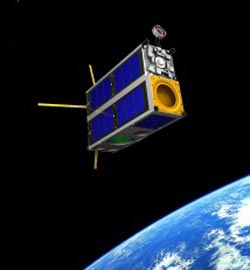Space@Virginia Tech to Lead New NSF Satellite Study to Improve Communications

Virginia Tech<br> <br>The Virginia Tech instruments placed on this nano-satellite will allow the researchers to understand how waves generated by weather systems in the lower atmosphere propagate and deliver energy and momentum into the mesosphere, lower thermosphere, and ionosphere.<br>
Propagating at this same height are radio waves and global positioning system (GPS) signals. As these signals interact with the electrically charged atmosphere their propagation is affected, sometimes in damaging ways. The result can be garbled signals and interrupted communications for users such as ham radio operators and radar trackers.
One of the main causes of these disruptions is thought to be waves generated in the lower atmosphere by weather systems. As these waves propagate upward they distort the electrically active region, resulting in instabilities at high altitudes that perturb the medium through which GPS and radio signals propagate.
Researchers at Virginia Tech are teaming with scientists from three other groups to build a small satellite dedicated to global observations of these waves in the mesosphere, thermosphere, and ionosphere, the atmospheric layers above the earth.
The National Science Foundation (NSF) is funding this work, capped at $900,000, and Greg Earle, a professor of electrical and computer engineering at Virginia Tech, is leading the work.
Earle’s research group is part of the Space@Virginia Tech research center. The group is working on this project in collaboration with colleagues and students led by Gary Swenson of the remote sensing and space sciences group at the University of Illinois. Rebecca Bishop from The Aerospace Corporation is providing some of the electrical instrumentation for the mission, and Sharon Vadas from the Colorado Research Associates will use sophisticated computational models to help interpret data from the satellite.
NSF created its CubeSat-based Science Missions for Geospace and Atmospheric Research to address the need for obtaining key measurements from low-cost satellite missions. NSF cites the recent advances in sensor and spacecraft technologies, allowing the recording of multi-point observations in space, as reasons why the timing is right to launch new satellites to improve the understanding of the geospace and atmospheric sciences.
Earle’s plan calls for a specially designed nano-satellite to be placed in orbit for about nine months in the earth’s atmosphere, at an altitude of about 300 to 400 kilometers or about 1 million feet. The Virginia Tech and Illinois investigators are calling the satellite the lower atmosphere/ionosphere coupling experiment or LAICE.
With the satellite traveling in low earth orbit, Earle said they will be able to “understand how waves generated by weather systems in the lower atmosphere propagate and deliver energy and momentum into the mesosphere, lower thermosphere, and ionosphere. These waves are a vitally important but under-explored facet of atmospheric physics. They strongly influence the dynamics of the media through which they travel by modifying the structure of the atmosphere at altitudes well above their source regions, and they may seed the development of plasma instabilities that scintillate and disrupt radio propagation.”
This global satellite investigation is the first to focus entirely on these waves in an attempt to connect their causes and effects in the three widely different altitude ranges.
The satellite’s recordings will include the disturbances the waves produce in both neutral and ion densities at specific heights.
The researchers will compare the measurements they obtain with meteorological data to understand the connections between tropospheric storms and the lower atmospheric system that includes tropical storms, tornadoes, and even thunderstorms.
Earle said their goal includes the production of global maps of active gravity wave regions in the mid- and low-latitude ionosphere over multiple seasons at all local times, so that global patterns and climatological variations can be quantitatively compared to and correlated with terrestrial weather systems via ray-trace modeling.
Others from Virginia Tech working with Earle on this project include: Kevin Shinpaugh of the Virginia Bioinformatics Institute; Ryan Davidson, of Blacksburg, Va., a post-doctoral associate in Earle’s research group; Chad Fish of Utah State University who is on sabbatical at Virginia Tech; Robert Robertson of McLean, Va., a graduate student in aerospace and ocean engineering; Lucy Fanelli, of New York, N.Y., a graduate student in electrical and computer engineering; Rehan Syed of Centrville, Va., a senior in aerospace and ocean engineering; Cameron Orr, of Yorktown, Va., a senior in electrical and computer engineering; Stephen Noel, of Christiansburg, Va., a graduate student in aerospace and ocean engineering and project manager; and Peter Marquis, of King George, Va., an undergraduate in aerospace and ocean engineering.
Space@Virginia Tech was founded in 2007, and is comprised of eight faculty members, all of whom have international reputations in the fields of space science and engineering.
Media Contact
More Information:
http://www.vt.eduAll latest news from the category: Physics and Astronomy
This area deals with the fundamental laws and building blocks of nature and how they interact, the properties and the behavior of matter, and research into space and time and their structures.
innovations-report provides in-depth reports and articles on subjects such as astrophysics, laser technologies, nuclear, quantum, particle and solid-state physics, nanotechnologies, planetary research and findings (Mars, Venus) and developments related to the Hubble Telescope.
Newest articles

Superradiant atoms could push the boundaries of how precisely time can be measured
Superradiant atoms can help us measure time more precisely than ever. In a new study, researchers from the University of Copenhagen present a new method for measuring the time interval,…

Ion thermoelectric conversion devices for near room temperature
The electrode sheet of the thermoelectric device consists of ionic hydrogel, which is sandwiched between the electrodes to form, and the Prussian blue on the electrode undergoes a redox reaction…

Zap Energy achieves 37-million-degree temperatures in a compact device
New publication reports record electron temperatures for a small-scale, sheared-flow-stabilized Z-pinch fusion device. In the nine decades since humans first produced fusion reactions, only a few fusion technologies have demonstrated…





















